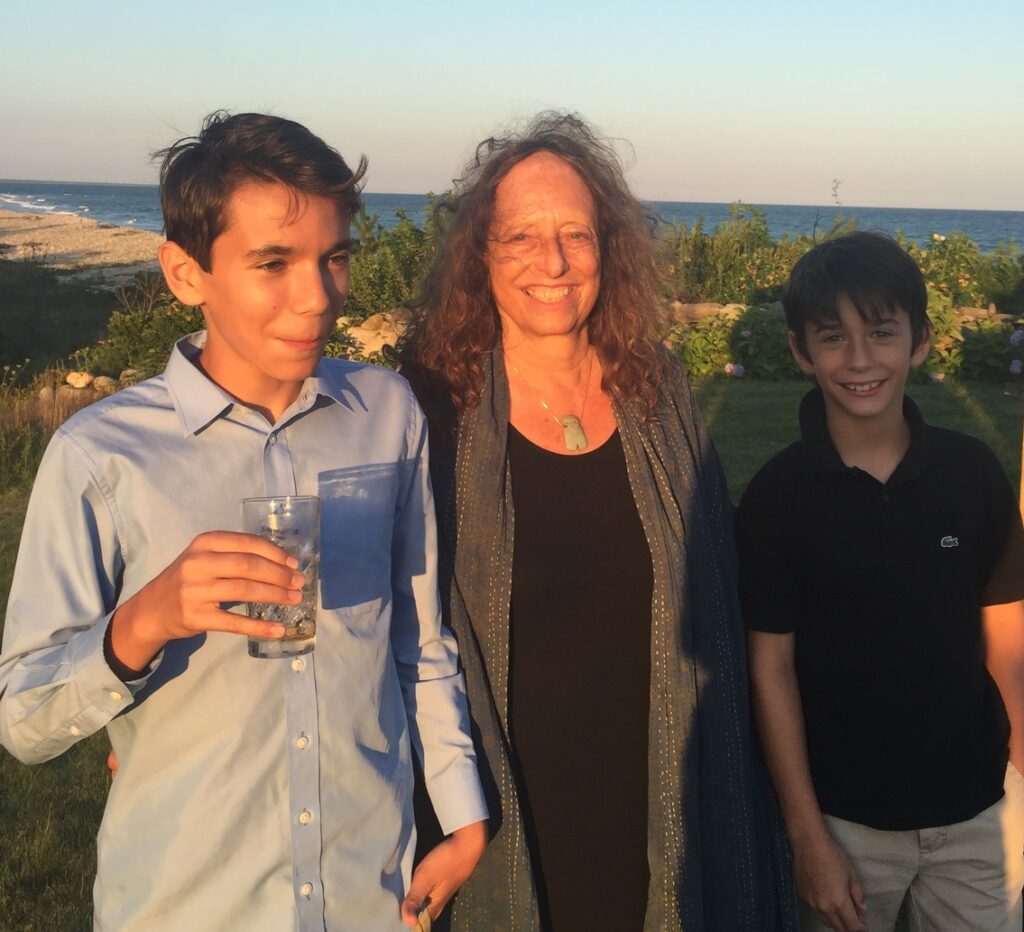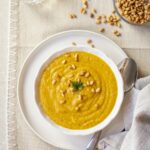An ethicist who cares about the world — and food.
Carol Gilligan’s groundbreaking 1982 gender studies classic, In a Different Voice, put her on the map as a psychologist, a feminist, and an ethicist. But she’s also an educator who currently teaches a wildly popular course on listening at New York University, a novelist, and an excellent cook. She’s been married for sixty-four years to psychiatrist and violence expert James Gilligan (“Sixty-four years!” she exclaims. “We’re in the Museum of Natural History!”), and she has three children and six grandchildren. When she’s at her Martha’s Vineyard house in Aquinnah in warm weather, she tries to start every day with a swim in the ocean.
Some forty years ago, Carol developed a theory called “the Ethics of Care,” centered around what she learned when interviewing women for In a Different Voice. Rather than focusing on abstract ideals like “justice” or “fairness,” care ethics posits that when people (particularly women) make moral decisions, they consider how their actions might affect others. It takes into account relationships, community, and interdependence. Recently, it’s having a resurgence of popularity, showing up in the curricula of higher education institutions worldwide, as well as at the annual meetings of professionals in fields like nursing. It underlies the many conversations taking place across the globe about the intersection of social justice and environmentalism, and about the rights of species other than human beings.
The Ethics of Care used to be seen as a feminine thing, a woman thing, but now, there’s this awareness that we all need to start taking care of the world, of our future, of ourselves and each other. –Carol Gilligan
“I remember having this image of a trampoline,” Carol says; “you step on it in China, and you feel it in Brazil. Climate change just brings all that to the forefront. It’s all about interdependence, and everything being connected. The Ethics of Care used to be seen as a feminine thing, a woman thing, but now, there’s this awareness that we all need to start taking care of the world, of our future, of ourselves and each other.”
Anyone lucky enough to eat dinner at Carol’s house will recognize immediately that the Ethics of Care inform her cooking. She cares about nourishing her guests with fresh, local food cooked simply but deliciously. And she cares about talking and being together: while she cooks, the rest of us sit on tall stools around her kitchen island, chatting and snacking on what is always a bountiful array of appetizers. Generally, there will be sashimi from the Net Result or any of our local fish markets; local farm cheeses from Grey Barn or Mermaid, or others; and farm-grown string beans that have been barely boiled, then tossed with lemon juice, salt, and a dash of olive oil — a technique she learned from a waiter at a restaurant in Italy (and which she also uses with vegetables like asparagus and broccoli, depending on what looks good at the farmers’ market). “I like the idea that you can make your hors d’oeuvres both nutritious and also beautiful,” she says — the bright green of the beans, the red slices of raw tuna, the creamy center of a cheese encased in an orange-colored rind.
“I love it when one of my guests cooks with me,” she adds. Noting that when on the Vineyard, she and Jim eat mostly fish, she says that “with fish, you want to cook it until it’s just done, not overdone, and there’s a tension in that; I love having someone to share that with. I like it when I can say ‘come and taste this; does it need more salt?’”

Carol grew up in a Jewish household on the Upper West Side of Manhattan. As was true of all her neighborhood friends, the person who cooked in her house was an employee. But though her mother didn’t do the cooking herself, she was, Carol says, “basically an artist by nature, so there were always great aesthetics to food in our house, and an appreciation for good food.” Her mother planned menus and clipped recipes from the New York Times, and their housekeeper, Lily May, cooked them.
“When I got married,” Carol says, “I had never cooked anything. I remember calling Lily May and asking, ‘How do you cook spinach?’ I mean, I had no idea!”
Cooking didn’t become an important part of Carol’s life until the 1960s, when she and Jim had young children and were living in Newton. In those days, children came home from school for lunch every day, and two afternoons a week — left open for music lessons and dentist appointments — they didn’t return to school. “This was a time when a lot of women were going back for their degrees,” Carol says, “but I already had my Ph.D and was at home, so I often took care of a lot of the other children in the neighborhood along with my own. One of my activities with the children on those afternoons was baking bread.” That, she says, was the beginning of her love affair with cooking. Soon, she and her children were cooking dinner together.
“Late in the day, when the children’s patience was frayed,” she says, “we would gather in the kitchen and chop vegetables and sort of chat, but you didn’t have to talk. It didn’t have to be a conversation; we’d just hang out. My children remember that, and all my boys now cook as a result. And I learned to love cooking; I still do. At the end of a day of writing, or copyediting (the obsessiveness of that drives me crazy), the thought of chopping an onion just seems very peaceful to me.”
Anyone lucky enough to eat dinner at Carol’s house will recognize immediately that the Ethics of Care inform her cooking. She cares about nourishing her guests with fresh, local food cooked simply but deliciously.
While Carol’s cooking on the Vineyard centers around fresh fish and local vegetables, in the wintertime, when she and Jim are in New York City, their evening socializing often takes place at restaurants. At home, she cooks simply and nutritiously, but always with care. “On regular nights, I don’t cook from recipes; I just see what I have, or start with what looks good at the market. Maybe I have some chicken in the fridge, and some bok choy, and some cashews, and I’ll throw them in a wok, and sometimes it comes out fantastically.”
Like all good cooks, she likes to have certain items always at hand, keeping her kitchen stocked with lemons, onions, eggs, garlic (“definitely, lots of garlic!”), and spices. When she sets out to make a meal, she tends to go in one of two spice-driven directions: Indian, or French/Italian, using either a combination of turmeric, cumin, coriander, and cinnamon, or a mixture of thyme, oregano, and basil. “With some produce, and some protein, and one of those combinations of spices, that’s dinner!” she says. “Sometimes I’ll cook some onions and garlic in a pan, add some chicken thighs and brown them, then I’ll add all the Indian spices, and it’s delicious. That to me is a simple and delicious weeknight dinner, and it doesn’t take a lot.”
You can find Carol’s books on Amazon. If you make a purchase through our links, including from Amazon, we may earn a small commission.
Here are two recipes Carol has been enjoying recently.
Print
Anti-Inflammatory Cauliflower Carrot Soup
- Yield: Serves 3 to 4 1x
Ingredients
- 1 large cauliflower head
- 3‒4 large carrots
- 1 leek
- 1/2 white onion
- 2‒3 cloves garlic
- 1 tablespoon fresh ginger
- 1 tablespoon fresh garlic
- 1/2 tablespoon dried turmeric
- 4 cups chicken stock or vegetable broth
- 1 14 oz. can coconut milk
- 1/4 cup olive oil
- Parsley and pine nuts for topping
- Avocado oil for roasting
Instructions
- Preheat oven to 400℉. Remove stem and leaves from cauliflower and chop. Remove stems from carrots. Slice leek, keeping only the white portion. Peel and chop the onion. Peel and mince the garlic and ginger.
- Toss cauliflower and carrots with a drizzle of avocado oil, then sprinkle with salt and pepper. Spread onto a baking sheet and roast for 20‒25 minutes, or until vegetables are caramelized and tender. Toss halfway through baking time.
- While vegetables are roasting, heat a large pot over medium heat. Add olive oil to the pan, then add leeks and onion. Season with salt and pepper. Cook, stirring occasionally, until fragrant and lightly browned (5‒6 minutes). Next, add ginger, garlic, and turmeric to the pot. Cook, occasionally stirring, for 4‒5 minutes.
- Add stock, coconut milk, roasted cauliflower, and carrots to the pot. Turn heat to high and bring the soup to a boil. Reduce heat to a simmer, cover, and cook for 10 minutes. While soup simmers, mince parsley and lightly toast pine nuts (if using for garnish).
- Remove soup from heat. Process until creamy and smooth in a high-speed blender, or use an immersion blender. Serve immediately. Soup will store in the refrigerator for up to a week, or in the freezer for three months.
Notes
Author’s note: I added a few squirts of ume plum vinegar to this soup at the end, and it gave it a nice extra zing. A little lemon or lime juice might also have worked well.

Choucroute
Ingredients
- 1/4 lb. bacon, cut into lardons
- 2 1.5-pint jars of sauerkraut
- 2 tablespoons butter
- 1 onion, cut in half lengthwise and then in thin slices crosswise
- 3‒4 carrots, cut in thin rounds
- 1 cup white wine
- Chicken stock
- 2 bay leaves
- 4 sprigs parsley
- 10 juniper berries*
- 10 peppercorns
- Meat of choice**
* If you can’t find juniper berries, allspice berries, lightly crushed with a mortar and pestle, can be substituted.
** Carol says: “If I want to add meat, I brown a small rack of baby back ribs on the stove and bury them in the sauerkraut midway through the cooking, so that when the dish is ready, the meat is almost falling off the bones.” The author browned some turkey sausage on the stove and added it at the end.
Instructions
- Simmer the bacon pieces in water for about ten minutes to remove some of the fat. Drain.
- Soak the sauerkraut in cold water until it’s reached the level of saltiness that you want. Pour it into a colander and squeeze out the excess water.
- In a Dutch oven with a lid, melt the butter, then add the bacon, onion, and carrots and cook until the onions have softened. Add the sauerkraut, toss and mix, then cook for 10 minutes, stirring occasionally.
- Add 1 cup white wine and enough chicken stock to just cover the sauerkraut.
- Make a bouquet garni by wrapping the bay leaves, parsley, juniper berries, and peppercorns in a square of cheesecloth and tying it into a bundle with kitchen string. Bury it in the sauerkraut.
- Preheat oven to 325℉. Bring the pot to a simmer on the stove, then turn off heat, cover the sauerkraut with a round of buttered parchment paper, and place the pot in the oven. Cook 3‒5 hours.
- Remove from oven. Remove bouquet garni. Serve with mashed potatoes if desired.

